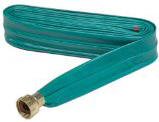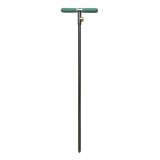- Avoid evaporation:
- Adapt lawn care to conditions:
- Use mulch:
When the air is hot, the water resting on the soil will evaporate before it soaks into the ground. To avoid high levels of evaporation it is best to water in early morning or late evening when air temperatures are lower.
Allow the grass on your lawn to grow as this will shade the roots from high daytime temperatures. A grass height of 3 inches is suggested. Be cautious when using nitrogen fertilizers as they promote the growth of new grass sprouts that will draw precious water.
One of the biggest benefits of mulch is that it shields the soil and prevents water evaporation. The use of mulch will reduce the amount of water necessary to keep plants, trees and shrubs healthy. Use a 2 to 3 inch thick layer of organic mulch, over the root areas.
Note: Avoid having any mulch in contact with the stalks of plants or tree trunks as this can cause rot.

Figure 4 - Soaker hose

Figure 5 - Soaker ring

Figure 6 - Deep root irrigator
- Adjust watering practices:
Secondary to its water saving quality mulch will also prevent the growth of weeds, which are unsightly but more importantly rob the soil of moisture and nutrients.
The old methodology of watering an entire property, including driveways, walkways and in many cases the roadway, is a true waste of a precious resource. Watering must be directed at root areas, where it is needed.
- Soaker hoses, as shown in Figure 4 can be used to apply water directly to gardens, flower beds and rows of hedges. They can also be taken around the root areas of large trees.
- Soaker rings, as shown in Figure 5 are designed to circle a tree trunk. They come in a variety of sizes and are perfect for new tree plantings.
- For larger trees watering the first foot or so of soil does not provide moisture to the root system. In order to reach the roots of a larger tree it is necessary to place the water at a level of between 1 and 2 feet below the surface of the soil.
- To accomplish the task of providing water to the roots without having to saturate a lot of soil with water you can use a
deep root irrigator
, as shown in Figure 6. These devices are designed to directly inject the water below the surface of the soil to where the root system lies. - Drip irrigation is the perfect solution for watering plants of all types, sizes and species. It uses the least amount of water while providing an adequate supply of moisture to plant roots. In some areas, when the watering of any vegetation is banned due to drought, there is an exception for the use of drip irrigation systems.
Additional information on drip irrigation
- Container gardening:
Those involved in container gardening should also consider using techniques that can reduce the amount of water that the container plants require.
- Potting containers made of terra-cotta and bare wood will absorb substantial quantities of moisture.Use glazed, enameled or plastic planters to reduce the amount of water needed to keep roots moist.
- Place smaller containers in larger ones, as this will keep the inner planter cooler and hence, will reduce the amount of evaporation.
- Use the correct size pot. A larger planter holds more soil and requires more water to keep the soil moist.
- Use containers when planting in flower beds in order to control the root area that must be watered.
